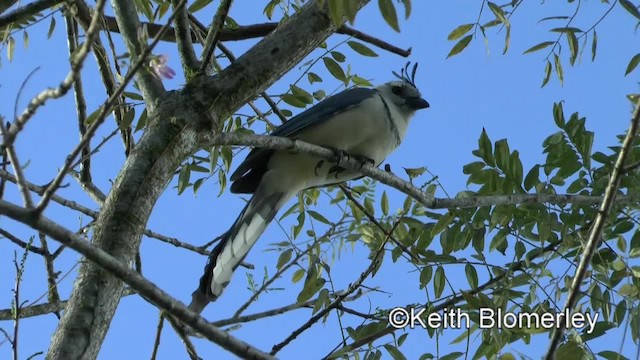White-throated Magpie-Jay Cyanocorax formosus Scientific name definitions
Revision Notes
Sign in to see your badges
Species names in all available languages
| Language | Common name |
|---|---|
| Bulgarian | Южна дългоопашата сойка |
| Catalan | garsa crestada gorjablanca |
| Croatian | bjelolica šojka |
| Dutch | Witkeelekstergaai |
| English | White-throated Magpie-Jay |
| English (United States) | White-throated Magpie-Jay |
| Estonian | haraknäär |
| French | Geai à face blanche |
| French (Canada) | Geai à face blanche |
| German | Weißkehl-Elsternhäher |
| Japanese | カンムリサンジャク |
| Norwegian | småskjæreskrike |
| Polish | srokal białogardły |
| Russian | Белогорлая сорочья сойка |
| Serbian | Belogrla svrakasta kreja |
| Slovak | kapuciarka čiernopása |
| Spanish | Urraca Hermosa Cariblanca |
| Spanish (Costa Rica) | Urraca Copetona |
| Spanish (Honduras) | Urraca Cola Larga |
| Spanish (Mexico) | Urraca Cara Blanca |
| Spanish (Panama) | Urraca Copetona |
| Spanish (Spain) | Urraca hermosa cariblanca |
| Swedish | vitstrupig skatskrika |
| Turkish | Ak Yakalı Saksağan Kargası |
| Ukrainian | Сойка білогорла |
Revision Notes
John van Dort revised and standardized the account with the Clements Checklist and curated the media. Guy Kirwan contributed to the Systematics page.
Cyanocorax formosus (Swainson, 1827)
Definitions
- CYANOCORAX
- formosis / formosum / formosus
The Key to Scientific Names
Legend Overview
Introduction
One of the better-studied New World jays, the White-throated Magpie-Jay is a large blue, black and white bird with a thin recurved crest and a long tail. It is found in open, dry habitats on the Pacific Slope from Jalisco, Mexico to southern Costa Rica, where it can often be seen roaming these landscapes in small noisy groups.
The White-throated Magpie-Jay is highly social and breeds cooperatively. Unusually among birds, the female offspring stay in the group and help their parents raise future broods, while male offspring disperse. Therefore, groups generally consist of a dominant female, her lone social mate, and a number of retained female offspring who feed the dominant female, nestlings, and fledglings. However, dispersing males (floaters) have carte blanche to enter territories and accompany groups while foraging. Floaters may visit multiple groups in a day, and group males show little aggression to them unless the dominant female is fertile.
Such a dynamic social scene lays the groundwork for a complex mating system. Dominant females are fairly faithful to their mates, but not entirely, with paternity going to both visiting floaters and to neighboring group males. Occasionally, a helper will start a nest of her own; she is not prevented from doing so, but the group will not help her unless the nest of the dominant female fails. In addition, helpers may act as brood parasites on the nests of their own mothers, laying eggs for the group to raise. Both sexes, therefore, compete for mating opportunities; males for a chance to pair with the dominant female, and females for the dominant position in the group.
Such reproductive skew within groups seems to have led to the evolution of one of the more astonishing vocal systems in the bird world. Males can individually produce upwards of 60 vocalizations (probably many more), but they do so in an unusual context. When a White-throated Magpie-Jay of either sex encounters a low-threat predator or even an innocuous species such as a dove or guan, they may fly slowly and directly at the threat, calling loudly. In this context males may produce a wide range of chirps, whoops, pops, yells and clicks. One possible explanation is that because males do not defend any resources needed by females, their best opportunity to be noticed by females is during predator encounters, when groups must pay attention to conspecific alarm calls.

- Year-round
- Migration
- Breeding
- Non-Breeding















































